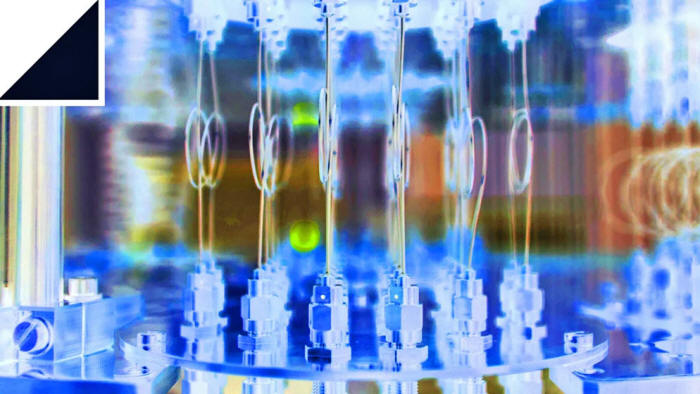|

September 27, 2022
from
TheSpaceAcademy Website

We are aware of how skewed our perception of reality is.
How we see the world
is shaped by our senses, our societies, and our knowledge.
And you may want to rethink your belief that science will always
provide you with objective reality.
Physicists can now verify
a hypothesis that Nobel Prize winner Eugen Wigner initially
put out in 1961.
The setting of the experiment, dubbed "Wigner's Friend," is not too
difficult.
You begin with a
quantum system that is in superposition, which implies that both
of its states exist concurrently up to the point of measurement.
In this example, the polarization (the axis on which a photon
spins) is both horizontal and vertical.
When they measure it, the
system will collapse and the photon will be stuck into one of those
two states.
Wigner's buddy is in the
lab doing the experiment. However, the quantum system - which,
crucially, also includes the lab - remains in superposition for
Wigner, who is outside the lab and uninformed of the outcome of the
experiment.
Despite having different outcomes, they are both accurate.
So, two objective
realities, Wigner's and Wigner's friend's seem to coexist. (This is
comparable to Schrödinger's cat, a thought experiment also involving
superposition, assuming Schrödinger and his cat-in-a-box were both
in a box.)
And that's a problem...
It has been impossible to test this theory for a very long time.
Wigner finds it difficult to calculate the quantum mechanics formula
after seeing his buddy do an experiment.
However, owing to recent
advances, scientists were able to create a quantum mechanics
experiment that would precisely replicate that.
A cutting-edge six-photon experiment and the system's four entangled
observers demonstrated that while one component of the system
generated a measurement, the other revealed that the measurement had
not been made.
At once, two
realities were measured...
According to the study,
this supports the claim made by quantum theories whose framework
already takes observer dependence into account.
"This calls into
question the objective status of the facts established by the
two observers," the scientists write in their paper, which is
available to
read on ArXiv.
Can their disparate
records be reconciled, or are they fundamentally incompatible -
making it impossible for them to be regarded as objective, observer
- independent "facts of the world"?
The influence and limits of the observers are well understood,
despite the fact that science is the finest instrument we have for
understanding reality. Observers may not see simultaneous
occurrences at the same time, according to relativity.
We learn from quantum physics that observers have an impact on their
experiments.
Now it seems that
two worlds may exist simultaneously, at least at the
quantum level...
Reference
A Quantum Experiment suggests there's...
No such thing as Objective Reality
by Emerging Technology
from the arXivarchive
March 12,
2019
from
TechnologyReview Website

IBM Research | Flickr
Physicists have
long suspected
that quantum
mechanics
allows two
observers to experience
different,
conflicting realities.
Now they've
performed
the first
experiment that proves it...
Back in 1961, the Nobel Prize–winning physicist Eugene Wigner
outlined a thought experiment that demonstrated one of the
lesser-known paradoxes of quantum mechanics.
The experiment shows how
the strange nature of the universe allows two observers - say,
Wigner and Wigner's friend - to experience different realities.
Since then, physicists have used the "Wigner's Friend" thought
experiment to explore the nature of measurement and to argue over
whether objective facts can exist.
That's important
because scientists carry out experiments to establish objective
facts.
But if they experience
different realities, the argument goes, how can they agree on what
these facts might be?
That's provided some entertaining fodder for after-dinner
conversation, but Wigner's thought experiment has never been more
than that - just a thought experiment.

Last year, however, physicists noticed that recent advances in
quantum technologies have made it possible to reproduce the
Wigner's Friend test in a real experiment.
In other words, it
ought to be possible to create different realities and compare
them in the lab to find out whether they can be reconciled.
And today,
Massimiliano Proietti at Heriot-Watt University in
Edinburgh and a few colleagues say they have performed this
experiment for the first time:
they have created
different realities and compared them...
Their conclusion is that
Wigner was correct - these realities can be made irreconcilable so
that it is impossible to agree on objective facts about an
experiment.
Wigner's original thought experiment is straightforward in
principle.
It begins with a
single polarized photon that, when measured, can have either a
horizontal polarization or a vertical polarization.
But before the
measurement, according to the laws of quantum mechanics, the photon
exists in both polarization states at the same time - a so-called
superposition.
Wigner imagined a friend in a different lab measuring the state of
this photon and storing the result, while Wigner observed from afar.
Wigner has no information
about his friend's measurement and so is forced to assume that the
photon and the measurement of it are in a superposition of all
possible outcomes of the experiment.
Wigner can even perform an experiment to determine whether this
superposition exists or not. This is a kind of interference
experiment showing that the photon and the measurement are indeed in
a superposition.
From Wigner's point
of view, this is a "fact" - the superposition exists.
And this fact
suggests that a measurement cannot have taken place.
But this is in stark
contrast to the point of view of the friend, who has indeed measured
the photon's polarization and recorded it.
The friend can even call
Wigner and say the measurement has been done (provided the outcome
is not revealed).
So the two
realities are at odds with each other.
"This calls into
question the objective status of the facts established by the
two observers," say Proietti and co.
That's the theory, but
last year Caslav Brukner, at the University of Vienna in
Austria, came up with a way to re-create the Wigner's Friend
experiment in the lab by means of techniques involving the
entanglement of many particles at the same time.
The breakthrough that Proietti and co have made is to carry
this out.
"In a
state-of-the-art 6-photon experiment, we realize this extended
Wigner's friend scenario," they say.
They use these six
entangled photons to create two alternate realities:
one representing
Wigner and one representing Wigner's friend.
Wigner's friend measures
the polarization of a photon and stores the result. Wigner then
performs an interference measurement to determine if the measurement
and the photon are in a superposition.
The experiment produces an unambiguous result.
It turns out that
both realities can coexist even though they produce
irreconcilable outcomes, just as Wigner predicted...
That raises some
fascinating questions that are forcing physicists to reconsider
the nature of reality.
The idea that observers can ultimately reconcile their measurements
of some kind of fundamental reality is based on several assumptions.
The first is that
universal facts actually exist and that observers can agree on
them.
But there are other
assumptions too.
One is that observers
have the freedom to make whatever observations they want.
And another is that
the choices one observer makes do not influence the choices
other observers make - an assumption that physicists call
locality.
If there is an objective
reality that everyone can agree on, then these assumptions all hold.
But Proietti and co's result suggests that objective reality
does not exist.
In other words, the
experiment suggests that one or more of the assumptions - the
idea that there is a reality we can agree on, the idea that we
have freedom of choice, or the idea of locality - must be wrong.
Of course, there is
another way out for those hanging on to the conventional view of
reality.
This is that there is
some other loophole that the experimenters have overlooked...
Indeed, physicists have
tried to close loopholes in similar experiments for years, although
they concede that it may never be possible to close them all.
Nevertheless, the work has important implications for the work of
scientists.
"The scientific
method relies on facts, established through repeated
measurements and agreed upon universally, independently of who
observed them," say Proietti and co.
And yet in the same
paper, they undermine this idea, perhaps fatally.
The next step is to go further:
to construct
experiments creating increasingly bizarre alternate realities
that cannot be reconciled.
Where this will take us
is anybody's guess.
But Wigner, and his
friend, would surely not be surprised...
Reference
|




